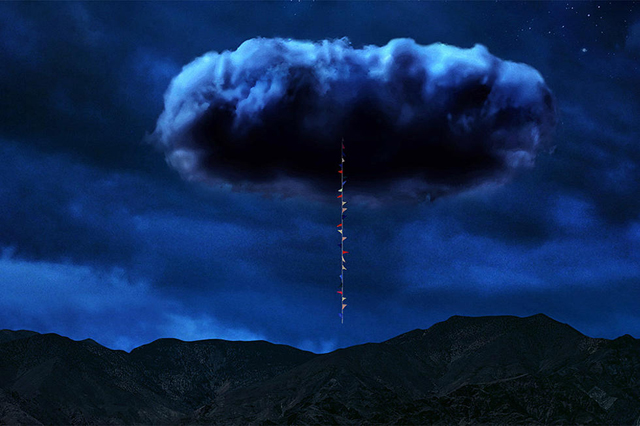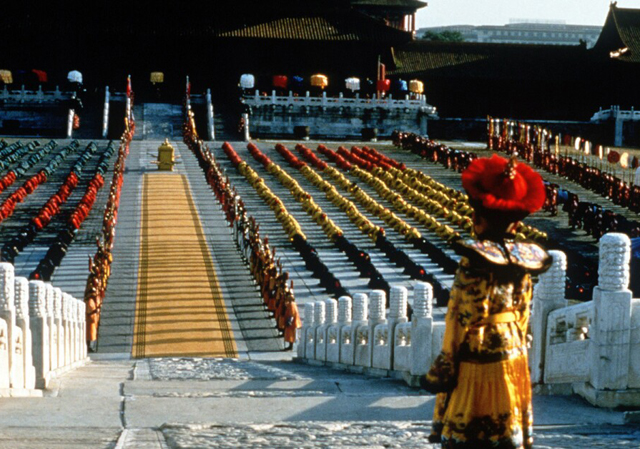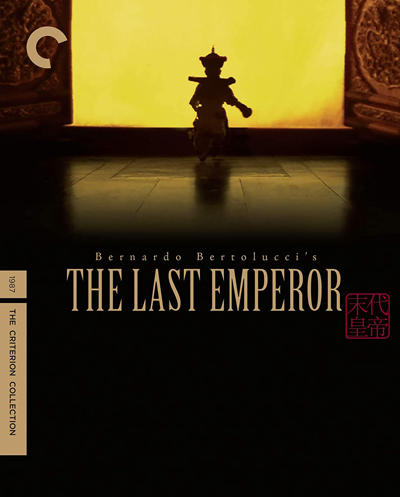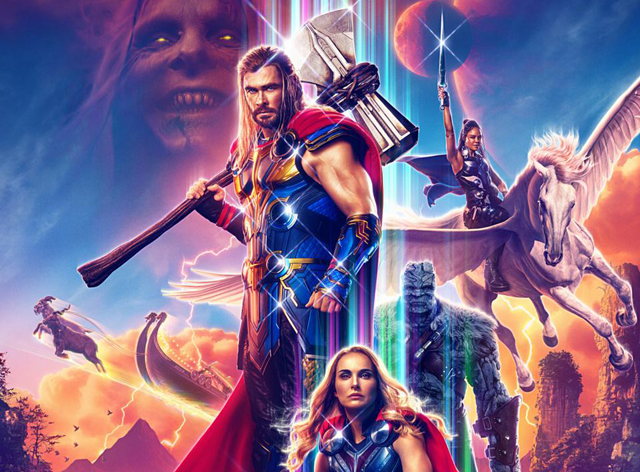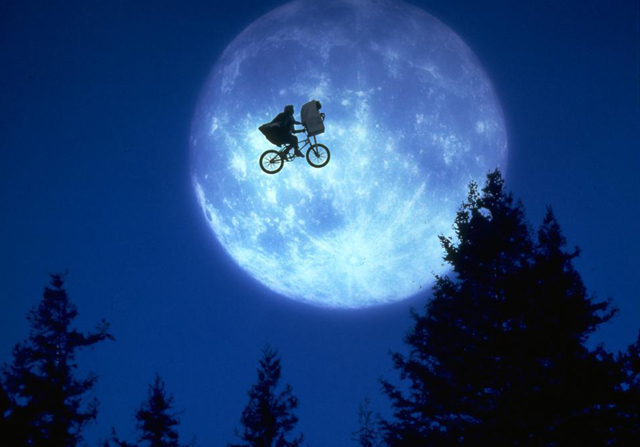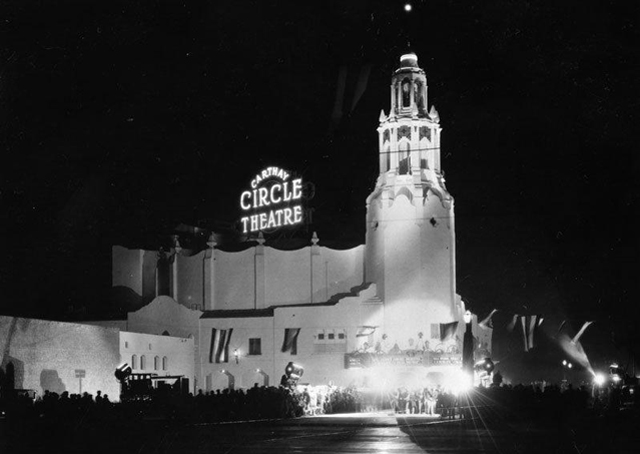
Today we are all used to going to the movie theaters at any numerous multiplex location in our area; most likely attached to malls or any other retail/dining complex destination. But, this wasn’t always how movies were presented to the public. Once upon a time, movies were distributed to locations across the country that operated out of single screen venues. Often these movie theaters of the past were old town halls or music venues that were converted into movie theaters once the artform began to mature into the cultural institution that it is today. The number of screens depended on the size of the community, but the venues themselves were big and spacious, dwarfing the amount of seating per screen at most movie theaters today. During the height of the studio system, new movie theaters began to spring up alongside these converted old music halls, and it created a flourishing of what became known as the Movie Palace. Not only did these movie theaters flourish during this time, but the owners put a great amount of investment into making them opulent and works of art on their own. But, the Paramount decision that broke up the studio system in the 1950’s also disrupted the revenue stream that kept many of these palaces alive. Over time, it just wasn’t economically sound to continue rolling out movies slowly to these single screen venues. Soon, the multiplex became the preferred theatrical model for Hollywood, and the movies palaces slowly died out across the country, many being demolished or returning back to their previous status as a concert venue. Still, there are many movie palaces of the glory days of Hollywood that have managed to survive, either through community support, heritage protection status, or generous funding from wealthy investors. You can find many of these movie palaces sprinkled throughout the country, but perhaps the biggest concentration of them anywhere can be found right in the heart of Hollywood itself.
Hollywood is more than just the center of the movie industry. It is a destination of it’s own, drawing in visitors from around the world. The heart of tourism in Hollywood is naturally the street that gave the industry it’s namesake; Hollywood Boulevard. There you’ll find the Hollywood Walk of Fame as well as famous haunts of the Hollywood Elite like Crossroads of the World, The Roosevelt Hotel, and Musso & Frank’s Bar and Grill. But of course the biggest draw in Hollywood is the collection of iconic movie theaters that line up along Hollywood Blvd, as well as on the side streets of Vine, Highland, and Sunset. There were many more theaters that used to line these streets of the past, but the survivors that still operate today continue to be a big draw and are among the most famous movie theaters in the world. These movie theaters also are where the biggest film premieres take place, with A-list talent riding up Hollywood Blvd. in their limos quite frequently throughout the year. No wonder the Dolby Theater, home of the Academy Awards, was built in this same neighborhood. But, Hollywood Blvd. is not the only place around Hollywood that has managed to retain their own legendary movie palaces. There are other great one of a kind movie theater experiences found across Los Angeles connected to the Golden Age of Hollywood, and are still very popular among the local Angelino community. What follows is my list of the top 10 theater experiences in the Greater Hollywood area. I have seen at least one movie in all of these theaters, so I’m basing my choices on personal insight. For a theater to make it on my list, it has to be a singular unique venue. It can be part of a theater chain and have an adjoining smaller screen connected to it, but the theater must be currently operational or in the process of being renovated for film screening purposes, solely used for movie screenings, and independent of other theaters of it’s kind. So no legendary closed theaters of the past like the Carthay Circle or the Pacific, or a converted venue like the Pantages or Avalon Theaters, which have long since been used for performances instead of film. So, let’s take a look at the best movie theaters around the heart of Hollywood.
10.
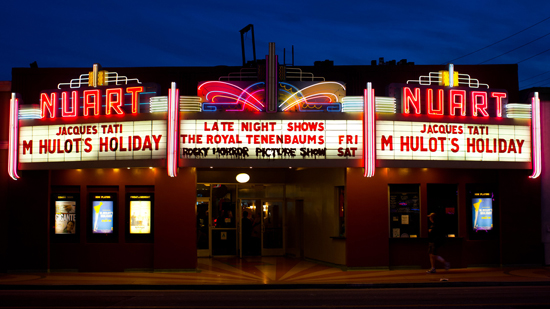
THE NUART THEATER
Location: West Lost Angeles, Santa Monica, Blvd.
The Nuart Theater may be the most outlying theater in the vicinity of Hollywood within the Los Angeles city limits. It’s far out near Santa Monica in the Sawtelle neighborhood, literally right next to the 405 freeway that crosses by it. One would say that it’s as far away from the glitz and glamour of Hollywood as you can get for an independent movie house in LA. So, what makes it so special. Over time, the Nuart has used it’s outsider status to become a haven for Avant Garde and revolutionary cinema. The movie theater started out like any other movie palace of the past, opening in 1929 on the Santa Monica Blvd. stretch that marked the final leg to the ocean of the historic Route 66. Naturally, being on the thoroughfare that many beach goers were taking to reach those famous coastal waves, the Nuart attracted a younger crowd, and likewise their line-up of movies catered to their cinematic tastes. In the counterculture 60’s and 70’s, the Nuart played host to many experimental films that were emerging from some of the industry’s most renegade filmmakers. Filmmakers like John Waters, David Lynch, and many other indie darlings were instrumental fixtures here during their rise as filmmakers. The theater has changed hands numerous times, but despite the change of management, it has still retained it’s art house cred within the community and in Hollywood in general. It’s probably best known today for it’s late night screenings, including it’s long tradition of the interactive screenings of the cult hit The Rocky Horror Picture Show (1975). Renovated extensively in 2006, the Nuart still retains it’s independent spirit while still keeping up with the most advanced technology, helping to give viewers the best possible experience with movies that fall outside of the Hollywood norm.
9.
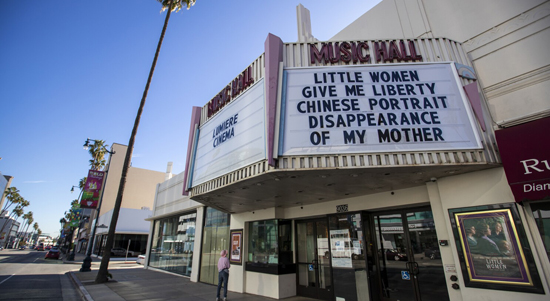
THE LUMIERE MUSIC HALL
Location: Beverly Hills, Wilshire Blvd.
The Music Hall has certainly one of the most storied histories among the local theaters in Hollywood. As the name suggests, it wasn’t always a movie theater. It operated as a venue for live entertainment and studio for radio and television since it’s opening in 1936 and up to 1956, when it made it’s conversion to movies. Like the Nuart, it specialized in art house cinema, becoming an especially popular place for foreign imports. It operated for over 40 years under the local Laemmle chain, until the lease was up in 2019, and the landlord began exploring other options for the building that the theater is attached to. Laemmle decided not to extend their lease and it looked like the longtime Beverly Hills fixture was going to close for good. However, a trio of Laemmle theater veterans decided to form their own management company to pick up the lease in order to keep the theater open independently. This new team of Luis Orellana, Lauren Brown and Peter Ambrosio were given a one year lease plus a renewal option to reestablish the theater and show that it could operate on it’s own. For a while, it looked like the Music Hall was saved. Then, only 5 months after the lease was set, the Covid-19 pandemic shut down movie theaters across the country. This was a devastating blow to the new managements plans. They were able to generate some revenue from movie streaming on their website as well as opening up their lobby to concession and merchandise sales, but these were paltry compared to the money lost from no ticket sales. Thankfully, the lease was given an extension and the theater did re-open in March of 2021. It continues to run art house movies on it’s three screens. The theater’s main theater, the 200 seat Auditorium 3 is the best preserved part of the theater that represents how it appeared in it’s early days. Though a small operation, it’s nevertheless an important fixture in the historical footprint of cinema in the Los Angeles area, and with it’s dedicated management team, it’s one that is dedicated to preserving the theatrical experience for years to come.
8.
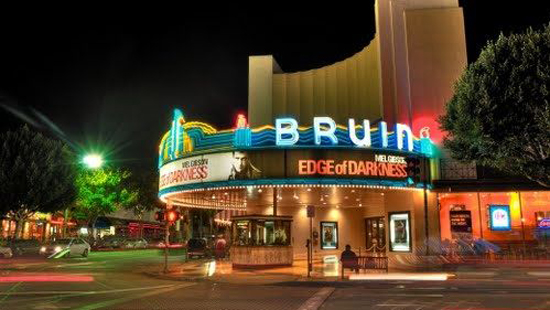
THE BRUIN THEATER
Location: Westwood Village, Broxton Ave.
If you’ve seen a movie theater appear in a Hollywood set movie, chances are it was this one. The Bruin Theater definitely has movie star looks to it, with it’s striking art deco façade. But, it’s actually not anywhere near Hollywood itself, instead being situated far off in Westwood, near the UCLA campus, taking it’s namesake from the university’s mascot. It’s been a fixture of Westwood since it’s opening in 1937 and is seated on the corner of Broxton and Weyburn Avenues, right across the street from it’s larger sister theater, the Fox Westwood Village Theater. The Bruin has a single level cascade style auditorium with a large screen capable of running everything from 35 to 70 mm. It’s a popular venue for movie premieres in the area, especially from the nearby 20th Century studio lot. But, what is interesting is that the Bruin has often appeared frequently in movies itself. Filmmakers such as John Frankenheimer, Robert Redford, and Paul Schrader have all used the Bruin as a location in their film. Most recently, Quentin Tarantino featured the Bruin in his period film Once Upon a Time in Hollywood (2019), with Margot Robbie’s Sharon Tate stopping by it to watch a movie that she herself starred in. Today, it still runs blockbuster films and is a favorite for the local student population from UCLA. Having been operated by Regency Theaters since 2010, the theater still maintains it’s art deco style and looks pretty much the same as it did when it first opened. It’s most defining feature is the blue and gold neon marquee out front, reflective of the universities school colors, as well as a shining example of mid century design that invokes the golden age of Hollywood. The spherical marquee alone makes this one of the most picturesque landmarks in the area, but the theater that is housed inside it, which still maintains it’s own art deco style, is also something that should not be missed.
7.
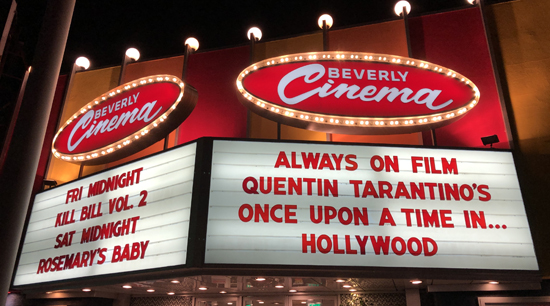
THE NEW BEVERLY CINEMA
Location: Fairfax, Beverly Blvd.
Speaking of Quentin Tarantino, we can’t talk about local Hollywood theaters without mentioning the one that the famed director owns an operates himself. The building that it is housed in dates back to 1929, but it wasn’t used as a theater until the 1950’s. Being a little out of the way from the heart of Hollywood, the Beverly Cinema specialized more on independent cinema, namely cheap grindhouse movies. Hence why this particular theater was so special to local aspiring filmmaker Quentin Tarantino. The theater over time ran into financial hard times during the 1980’s, resorting at one point to being a porno theater. As Tarantino began to gain clout in the movie industry, he sought to help out the struggling theater and spent much of his money helping to subsidize it. After the owner of the theater passed away, Tarantino jumped in and saved the theater from closing, purchasing it outright in 2007. The New Beverly Cinema as it has since been called now presents a series of screenings curated by the director with one key requirement; that it must be screened with real film. As Tarantino has said in his mission statement for the Beverly: “As long as I’m alive, and as long as I’m rich, the New Beverly will be there, showing double features in 35mm.” And that’s exactly what has happened. The theater has been renovated from it’s once duplex layout to a full single auditorium, and has become a favorite venue for film stock purists like Mr. Tarantino. The theater even holds special event screenings, with live discussions with filmmakers, including Tarantino and his closest friends. It’s a specialized venue where one is able to see classic films screened in the traditional style, but every now and then visitors may been even treated to a special showing of a first run movie, as long as it’s shown on film. It’s certainly a living tribute to the dedication of one prominent film fan who not only wants to preserve the experience of watching a movie, but to also maintain the uniqueness of the places in which the movies are seen.
6.
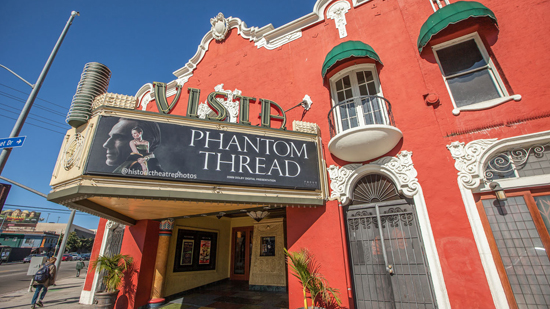
THE VISTA THEATER
Location: East Hollywood, Sunset Drive
On the far eastern edge of Hollywood is this single screen gem that has been a fixture of the nearby Los Feliz community. It’s outsider status among the movie palaces in the Hollywood area has helped to keep it unique in character from the rest. In particular, it has managed to remain a beautifully maintained time capsule of the movie palaces of early Hollywood. Built from the ground up in 1923 solely for the presentation of movies, The Vista is a beautiful art deco infused venue with Egyptian inspired interiors. The mix of old and new blends perfectly into a stunning palace for the movies. Like the Bruin, the Vista has itself appeared in a number of movies, probably most famously playing the part of the movie theater in the prologue of Wes Craven’s Scream 2 (1997). It went through it’s hard times in the 70’s and 80’s, at one time screening adult films for a while. But, it was picked up by the Landmark Cinemas chain and was renovated heavily in the 1990’s, helping to bring the theater back to it’s old glory. However, the Vista faced a huge crises when the Covid-19 pandemic hit. It left the Landmark chain in significant trouble, and in 2021 when the rest of the theater market was finally beginning to re-open, the Vista remained closed. The marquee out front still read the words “To Be Continued,” but that remained significantly in doubt as Landmark began downsizing after the blow of the pandemic. It was soon revealed that Landmark was putting the theater on the market, which left many movie fans worried, especially if the property fell into the hands of a developer with no intent on preserving the theater, instead choosing to demolish it in favor of upscale retail or housing. To everyone’s delight a buyer came forward with the intent of not only preserving the theater, but also bringing it back to it’s former glory. And that buyer is of course, you guessed it, Mr. Quentin Tarantino. Upon buying the property, Tarantino also started an extensive refurbishment of the whole theater, costing in the range of $6 million. Unlike the New Beverly Cinema, which runs a curated program of classic movies, Tarantino still intends to have first run movies play at the Vista like they had before, although his prerequisite of film stock presentations will still be in place. The theater is expected to finish it’s remodel in the next couple months and hopes to open to the public late 2022 or early 2023. One hopes that under Tarantino’s management the Vista will have a bright future ahead of it.
5.
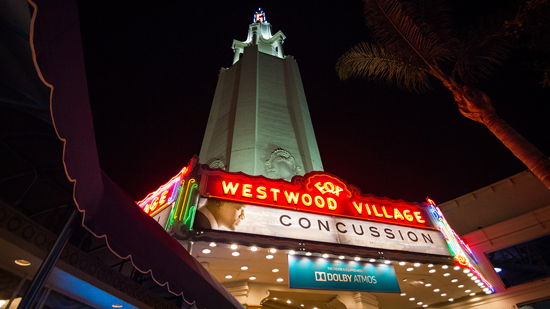
THE FOX WESTWOOD VILLAGE THEATER
Location: Westwood, Broxton Ave.
Located right across the street from the smaller Bruin, the Westwood Village theater dwarfs all others in the Hollywood area. Seating nearly 1,500 people, it’s the single largest movie theater in Los Angeles by capacity. With two levels of seating, audiences throughout the venue will have a perfect view of the enormous screen, capable of presenting film in the largest formats available, other than IMAX. Apart from the size of the venue, it’s also noteworthy for it’s skyscraping tower above the marquee. The 170 foot tower has been the centerpiece of the Westwood skyline since the theater first opened in 1931, and it looks pretty much the same as when it was first built. Not only has it been an iconic structural feature, but it’s also contributed to the marquee presentations of several films that have played there, with the spacious façade of the tower’s front view displaying large promotional banners and posters over the years. At night, the white tower stands out illuminated by spotlights, becoming an eye-catching sight for locals and tourists alike. Inside, the art deco influence remains about the same from the early days of the theaters history. In many ways, it’s the big brother equivalent of the nearby Bruin Theater. Inside, they look very similar, but the Westwood Village is just grander in scale. It’s an especially popular theater for the Hollywood elite. Not only is it visited my many movie stars that live in the area, but it’s also a popular venue for movie premieres as well. Some filmmakers such as Christopher Nolan and Paul Thomas Anderson have often cited the Westwood Village to be one of their favorite theaters in the world, which is pretty high praise. Like the Bruin, it’s also a popular hangout of the local UCLA student body, and it’s often where many of them will catch the latest blockbuster film, with the Bruin usually the better option for smaller, independent films. With it’s striking exterior and it’s immense scale, the Westwood Village certainly stands as the most striking example of the movie palace boom at it’s very peak, showing the presentation of film at it’s most epic scale, and setting the bar high for others like it.
4.
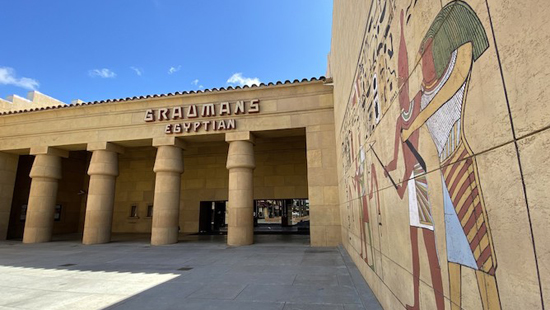
THE EGYPTIAN THEATER
Location: Hollywood, Hollywood Blvd.
Here is the granddaddy of them all. The Grauman’s Egyptian is the single oldest movie theater on Hollywood Boulevard that is still standing. Tucked away at the end of a courtyard in an alcove off of Hollywood Blvd, this venue is about to reach it’s century mark. Opened in 1922, this Egyptian themed theater has been a landmark for Hollywood throughout the years. In many ways, this was the theater that sparked the movie palace craze, with it’s attention to thematic architecture as a part of it’s appeal to audiences. Not only was the theming apparent from the outside, with the concrete walls carved to look like the ancient ruins of an Egyptian temple, complete with hieroglyph paintings and statues of Egyptian pharaohs, but the interior featured columns modeled after those found in Egypt and an ornate sunburst ceiling fixture inspired by art found in ancient Egyptian tombs. It was a magnificent architectural wonder for it’s time and a gem in the rising boom of movie palaces spreading across the heart of Hollywood. While most of the theaters around the Egyptian went away over the years, the classic icon managed to stay afloat. It remained a popular theater for many visiting Hollywood over the years. But, hard times in the 80’s led to it’s closing in 1992. Thankfully, it’s historical landmark status saved it from demolition and in 1996 American Cinematheque bought the theater with the provision of renovating it. Controversially, the theater was gutted of many of it’s ornate fixtures, most of which had fallen under disrepair over the years due to neglect. Thankfully, the forecourt was restored to it’s original glory. American Cinematheque maintained the renovated theater for 20 years, using it as a special venue for classic film screenings and discussions. But, in 2018, another interested party came in to purchase the theater for themselves; streaming giant Netflix. The purchase was finalized in 2019, with Netflix still allowing American Cinematheque permission to program screenings at the theater in addition to their own events. A renovation was planned as well, though it was delayed by a year due to the pandemic. The Egyptian is still in the middle of that extensive overhaul, which will include restoring the interior back to it’s original ornate beauty, and the hope is to have it open by the end of the year in order to have it open for the 100th anniversary. Let’s hope that Netflix gives the old theater the fresh update it deserves and continues to make it a must see landmark in the heart of Hollywood.
3.
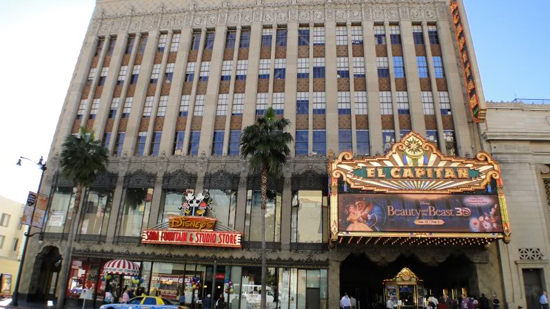
THE EL CAPITAN THEATER
Location: Hollywood, Hollywood Blvd.
The El Capitan is another survivor of the decline of classic movie palaces across the country and in Los Angeles. The venue was first opened in 1926, situated right across the street from where another icon would eventually emerge on Hollywood Boulevard, the Chinese Theater. Unlike the other theaters in the area, the El Capitan doesn’t stick out like with an iconic façade. It instead is tucked behind an office building, with it’s marquee entrance stretching out to the street. From the outside, it’s kind of an unassuming and even ugly structure, but looks are deceiving. On the inside you will find one of the most ornate and stunningly beautiful screening rooms in all of Hollywood. The interior is a beautiful mix of art deco and gothic combining into a wall to wall ambiance that in some ways may even overshadow what you are seeing on the screen. The theater has gone through many ups and downs over the years. It closed briefly in the 1930’s due to the effects of the Depression, and then re-opened as the Hollywood Paramount, eventually ending up in the ownership of United Artists thereafter. It’s final independent owners, Pacific Theaters, ended their ownership in 1989, and the El Capitan fell into disrepair while sitting empty. Then, in 1991, the theater re-opened under a new owner, the Walt Disney Company, who restored both the name and the theater itself to it’s original glory. It held it’s first premiere, The Rocketeer (1991) following the remodel and since then it has been Disney’s home for all of it’s world premieres, showcasing everything from their animated features to the latest Marvel and Star Wars films. Marvel Studios head Kevin Feige even chose the El Capitan as the venue to showcase to an excited crowd the then future Phase 3 plans for the Marvel Cinematic Universe. Whether you’re a Disney fan or not, the El Capitan is still a landmark theater well worth checking out. Not only does it give you a beautiful look at the ornateness of old Hollywood movie palaces, but it even has maintained another fixture of old Hollywood that most other theaters have removed over the years; a classic theater pipe organ, which is still played by a trained organist before select shows. Here you’ll have the best combination of the old and new Hollywood together; classic theater ambiance combined with Disney’s unparalleled theatricality and state-of-the-art presentations of the biggest new blockbusters.
2.
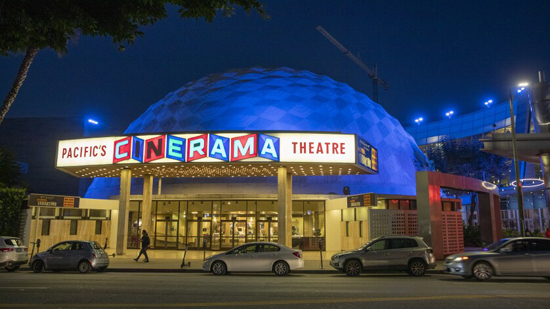
THE CINERAMA DOME
Location: Hollywood, Sunset Blvd.
A personal favorite of mine and for many Los Angeles locals, the Cinerama Dome is a venue unlike any other in the world. The youngest theater on this list by quite a stretch, it opened in 1963 as a venue custom built to present the new widescreen film format known as Cinerama. Cinerama was known for it’s immersive curved screen presentation, and what better way to spotlight that then to make the structure that the theater is housed in visually spherical itself. Situated near the corner of Hollywood and Vine, a short distance from the heart of Hollywood, the Cinerama Dome is unique for being the largest concrete geodesic dome in the world. The interior is a masterwork of mid-century design, with a sweeping curtain covering the length of the screen end of the auditorium and the whitewashed underside of the dome illuminated in the glow of golden light. Behind the curtain is the largest screen of it’s kind, an 85 foot wide curved behemoth that brings epic grandeur to anything that screens on it. It opened to the world with the premiere of Stanley Kramer’s epic comedy It’s a Mad, Mad, Mad, Mad World (1963), and has since hosted everything from 2001: A Space Odyssey (1968), to Apocalypse Now (1979) to several Star Wars and Titanic (1997). In 2002, property developer Decurion added onto the Cinerama dome by opening a large multiplex called the Arclight behind it. The Arclight and Cinerama Dome combined became a favorite for movie fans across Los Angeles, often rated at the top of all the movie theaters in the city. But, when the Covid-19 pandemic hit, it brought an abrupt end to the Arclight as a Hollywood fixture. The operators of the Arclight, Pacific Theaters, did not survive the lockdown and filed for bankruptcy in April of 2021. Fans of the theater were devastated and were concerned for the future of the property. The Dome itself is a protected landmark, but the Arclight structure behind it is not, and people were worried a new owner would end up gutting the property. Thankfully, Decurion managed to maintain ownership of the Arclight property even after selling off all the other Pacific Theater assets, and moves are being made to re-open the theaters again soon as a re-christened Cinerama Hollywood. One hopes that nothing other than the name will change, as the Arclight and the Cinerama Dome were the best in the business to begin with. When it finally, hopefully, re-opens, it is an essential theatrical experience that cannot be missed. Quite simply, this theater is the most unique theatrical experience of them all in Hollywood, and the place where the movies go to be the grandest they can be.
1.
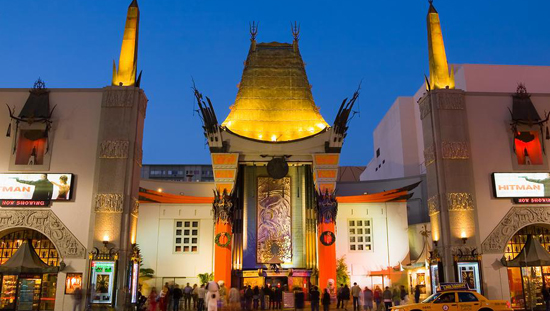
THE TCL CHINESE THEATER
Location: Hollywood, Hollywood Blvd.
The crown jewel of Hollywood. The Chinese Theater is not just the most famous movie theater in Hollywood, or Los Angeles, or the United States, but probably the world entire. It’s striking façade is just as iconic as the Hollywood Sign or the Griffith Observatory as a landmark in the Los Angeles region. Upon opening in 1927, it took the crown of the King of Hollywood Movie Palaces and has never relinquished the crown since in almost 100 years. Founded by Sid Grauman, who also owned the Egyptian and El Capitan theaters for a time in the early days of Hollywood, the Chinese Theater is an integral part of the history of Hollywood. This is especially true thanks to the tradition that still remains present in it’s courtyard. It’s said that when silent movie actress Norma Talmadge accidently got her heeled shoe stuck in wet cement in the new theater’s courtyard in 1927, it inspired Sid Grauman to start a tradition of movie stars leaving hand and shoe prints in cement as a permanent tourist attraction to bring more people to the theater. The tradition continues to this day, with footprints of all eras mixed in across the courtyard of the theater, from John Wayne to Judy Garland, to even Star War’s C-3PO. Inside, the Chinese inspired décor continues, leading to a gargantuan, ornate auditorium. The theater was extensively remodeled in 2013, sinking the seating floor several floors down in order to give the venue stadium style seating while still maintaining the ornate walls and ceiling of the original theater. The deeper floor to ceiling depth also allowed the Chinese to be converted into an IMAX theater, with a taller screen size that’s capable of supporting the large format. To this day, the Chinese Theater is the centerpiece of activity in Hollywood. No other landmark is more visited or photographed. Special events still are present there like movie premieres and also film festivals, like the Turner Classic Movies one that I attend every year. Certainly, no trip to Hollywood is complete without at least seeing the Chinese Theater. It is an icon in every way, and the pinnacle of the Hollywood movie palace experience.
There is no doubt that Hollywood is not just the heart of the movie industry, but also the best place to watch movies in a theatrical setting as well. It is home to the best and most famous movie theaters in the world, and offers both locals and visitors the best chance of feeling connected more personally to the movies as well. These are the theaters that the movie stars and filmmakers call home as well. In the case of the New Beverly, Lumiere Music Hall and Vista Theaters, it is indeed the ambitious public display of dedicated fans of the cinematic experience that keep these places running. I’m sure that there are plenty of movie palaces across the country that are as well preserved and well maintained and lovingly operated as those found in Hollywood. But there is no place in the world where you’ll find so many of these theaters so closely concentrated in one place. And I’m just spotlighting the ones in the vicinity of Hollywood, as there are plenty more scattered throughout the Southland, including in Downtown LA as well as communities like Santa Monica and Pasadena, each with their own storied histories. I have certainly spotlighted the major landmarks like the Chinese and the Cinerama Dome, but I also wanted Nuart and the Vista to get their due respect as well, as they are also a crucial part of the movie theater centered history of Hollywood. Living near Hollywood as I have for the last decade, I have been privileged to visit each of these unique venues, both small and large. They really tell you a story of what made Hollywood what it is today, showing how a lot of work went into making the theaters themselves part of the presentation. You just don’t get the same kind of feeling watching a movie in a standardized multiplex, though it’s still preferable to watching a movie on the couch at home. I do watch most of my movies at a multiplex, which themselves are grand in scale here in Los Angeles, but for special occasions, I will make an effort to see a film at the El Capitan or the Chinese, and hopefully again someday soon at the Cinerama Dome. If there is a unique movie palace in your area, or a small boutique arts cinema, please support them, because they don’t all have the historical protections that the ones here in Hollywood have. One-of-a-kind cinemas are something worth protecting, and the glory of the ones found here in Hollywood are great examples of what makes movie theaters so special to all of us.
